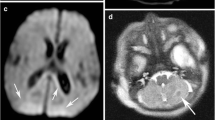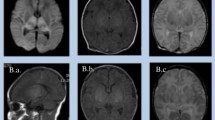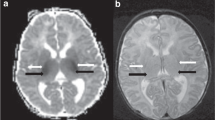Abstract
Background
Head US, the cornerstone neuroimaging modality in neonates, is believed to be less sensitive than MRI for detecting hypoxic ischemic injury (HII). Most reports comparing these modalities are retrospective and have a long interval between the exams.
Objective
To prospectively characterize the range of abnormalities found in US examinations performed within 2 h of brain MRI in encephalopathic neonates.
Materials and methods
A total of 76 consecutive exams met our inclusion criteria. Diagnostic performance of the US images was prospectively compared with MRI.
Results
MRI was considered positive for HII in 53 neonates. Of the remaining 23, MRI was negative for HII in 9, showed white matter abnormalities unrelated to HII in 8, and was inconclusive in 6. Of the 70 neonates with conclusive examinations, the US exam was regarded as positive in 67. Diagnostic accuracy of US was 95.7%.
Conclusion
Our study demonstrates that US should still be regarded as a screening test in neonates. US is more sensitive for the detection of injury than previously reported, and more attention should be paid to proper US technique. MRI shows disease more extensively and should be accomplished as early as possible.










Similar content being viewed by others
References
Woodward LJ, Anderson PJ, Austin NC et al (2006) Neonatal MRI to predict neurodevelopmental outcomes in preterm infants. N Engl J Med 355:685–694
Miller SP, Cozzio CC, Goldstein RB et al (2003) Comparing the diagnosis of white matter injury in premature newborns with serial MR imaging and transfontanel ultrasonography findings. AJNR 24:1661–1669
Debillon T, N’Guyen S, Muet A et al (2003) Limitations of ultrasonography for diagnosing white matter damage in preterm infants. Arch Dis Child Fetal Neonatal Ed 88:F275–F279
Sie LT, van der Knaap MS, van Wezel-Meijler G et al (2000) Early MR features of hypoxic-ischemic brain injury in neonates with periventricular densities on sonograms. AJNR 21:852–861
Blankenberg FG, Loh NN, Bracci P et al (2000) Sonography, CT, and MR imaging: a prospective comparison of neonates with suspected intracranial ischemia and hemorrhage. AJNR 21:213–218
Inder TE, Anderson NJ, Spencer C et al (2003) White matter injury in the premature infant: a comparison between serial cranial sonographic and MR findings at term. AJNR 24:805–809
Childs AM, Cornette L, Ramenghi LA et al (2001) Magnetic resonance and cranial ultrasound characteristics of periventricular white matter abnormalities in newborn infants. Clin Radiol 56:647–655
Mirmiran M, Barnes PD, Keller K et al (2004) Neonatal brain magnetic resonance imaging before discharge is better than serial cranial ultrasound in predicting cerebral palsy in very low birth weight preterm infants. Pediatrics 114:992–998
Maalouf EF, Duggan PJ, Counsell SJ et al (2001) Comparison of findings on cranial ultrasound and magnetic resonance imaging in preterm infants. Pediatrics 107:719–727
Daneman A, Epelman M, Blaser S et al (2006) Imaging of the brain in full-term neonates: does sonography still play a role? Pediatr Radiol 36:636–646
Thomson GD, Teele RL (2001) High-frequency linear array transducers for neonatal cerebral sonography. AJR 176:995–1001
Yikilmaz A, Taylor GA (2008) Cranial sonography in term and near-term infants. Pediatr Radiol 38:605–616, quiz 718–719
Di Salvo DN (2001) A new view of the neonatal brain: clinical utility of supplemental neurologic US imaging windows. Radiographics 21:943–955
Correa F, Enriquez G, Rossello J et al (2004) Posterior fontanelle sonography: an acoustic window into the neonatal brain. AJNR 25:1274–1282
Enriquez G, Correa F, Aso C et al (2006) Mastoid fontanelle approach for sonographic imaging of the neonatal brain. Pediatr Radiol 36:532–540
Heinz ER, Provenzale JM (2009) Imaging findings in neonatal hypoxia: a practical review. AJR 192:41–47
Barkovich AJ (2006) MR imaging of the neonatal brain. Neuroimaging Clin N Am 16:117–135, viii–ix
Winter JD, Lee DS, Hung RM et al (2007) Apparent diffusion coefficient pseudonormalization time in neonatal hypoxic-ischemic encephalopathy. Pediatr Neurol 37:255–262
Barkovich AJ, Miller SP, Bartha A et al (2006) MR imaging, MR spectroscopy, and diffusion tensor imaging of sequential studies in neonates with encephalopathy. AJNR 27:533–547
Steggerda SJ, Leijser LM, Walther FJ et al (2009) Neonatal cranial ultrasonography: how to optimize its performance. Early Hum Dev 85:93–99
Steggerda SJ, Leijser LM, Wiggers-de Bruine FT et al (2009) Cerebellar injury in preterm infants: incidence and findings on US and MR images. Radiology 252:190–199
Mader I, Schoning M, Klose U et al (2002) Neonatal cerebral infarction diagnosed by diffusion-weighted MRI: pseudonormalization occurs early. Stroke 33:1142–1145
Ward P, Counsell S, Allsop J et al (2006) Reduced fractional anisotropy on diffusion tensor magnetic resonance imaging after hypoxic-ischemic encephalopathy. Pediatrics 117:e619–e630
Coughtrey H, Rennie JM, Evans DH (1997) Variability in cerebral blood flow velocity: observations over one minute in preterm babies. Early Hum Dev 47:63–70
Taylor GA (1994) Alterations in regional cerebral blood flow in neonatal stroke: preliminary findings with color Doppler sonography. Pediatr Radiol 24:111–115
Steventon DM, John PR (1997) Power Doppler ultrasound appearances of neonatal ischaemic brain injury. Pediatr Radiol 27:147–149
Riccabona M, Resch B, Eder HG et al (2002) Clinical value of amplitude-coded colour Doppler sonography in paediatric neurosonography. Child Nerv Syst 18:663–669
Widjaja E, Shroff M, Blaser S et al (2006) 2D time-of-flight MR venography in neonates: anatomy and pitfalls. AJNR 27:1913–1918
Zimmerman RA, Bilaniuk LT, Pollock AN et al (2006) 3.0T versus 1.5T pediatric brain imaging. Neuroimaging Clin N Am 16:229–239, ix
Rademaker KJ, Uiterwaal CS, Beek FJ et al (2005) Neonatal cranial ultrasound versus MRI and neurodevelopmental outcome at school age in children born preterm. Arch Dis Child Fetal Neonatal Ed 90:F489–F493
Author information
Authors and Affiliations
Corresponding author
Rights and permissions
About this article
Cite this article
Epelman, M., Daneman, A., Kellenberger, C.J. et al. Neonatal encephalopathy: a prospective comparison of head US and MRI. Pediatr Radiol 40, 1640–1650 (2010). https://doi.org/10.1007/s00247-010-1634-6
Received:
Revised:
Accepted:
Published:
Issue Date:
DOI: https://doi.org/10.1007/s00247-010-1634-6




